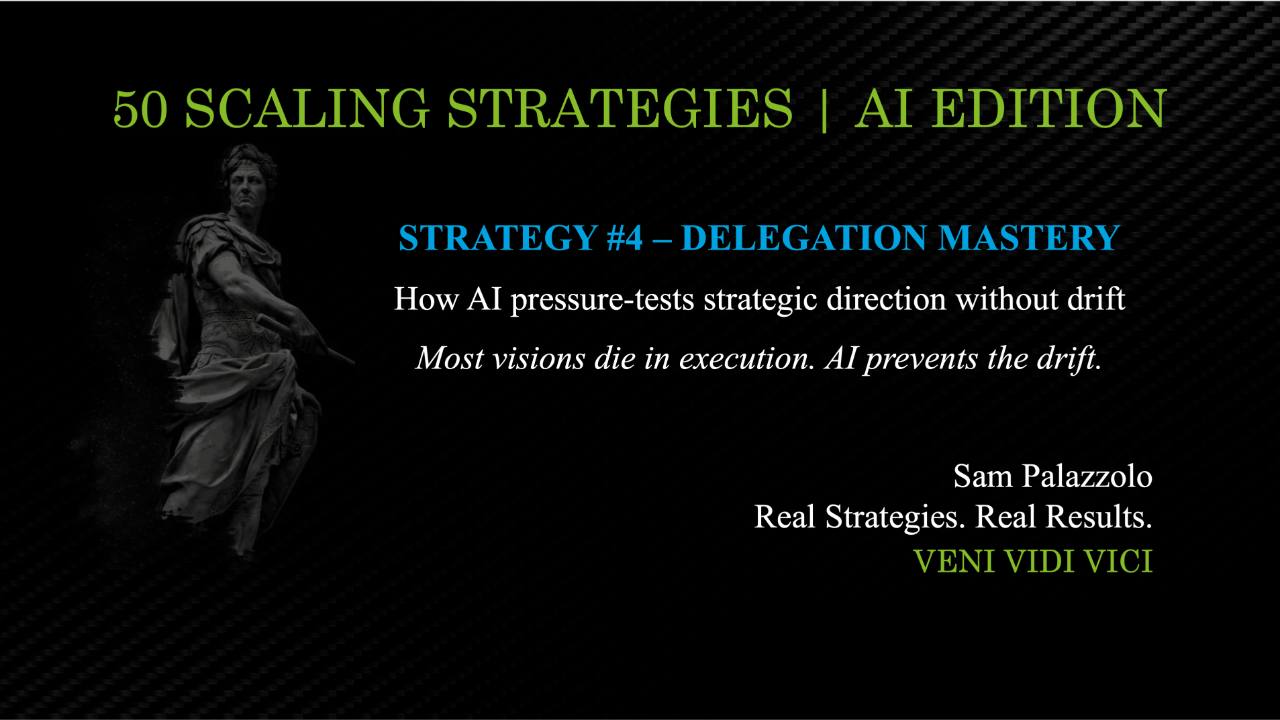Delegation at Scale: How AI Strengthens Leadership Efficiency and Execution Velocity
Nov 14, 2025
As organizations grow, the demands on leadership evolve faster than most teams are prepared to handle. The complexity that accompanies scaling—new markets, expanded product lines, additional management layers, and higher stakeholder expectations—creates an environment where traditional, intuition-based delegation no longer works. The result is predictable: bottlenecks, slowed execution, uneven accountability, and senior leaders who become structural constraints rather than force multipliers.
Delegation is not a soft skill. In scaling organizations, it is an operating system. And it fails not because leaders “don’t trust their teams,” but because companies have no formal mechanism for defining decision rights, ownership, and accountability at scale.
Artificial intelligence is changing that dynamic. By analyzing communication flows, decision patterns, performance data, and cross-functional interactions, AI can expose the hidden friction points that erode delegation—and provide a blueprint for rebuilding it as a strategic advantage.
This article breaks down how AI strengthens delegation, why it often collapses during growth, and how leaders can redesign their organizations to execute faster with less friction and significantly more clarity.
Why Delegation Fails in Scaling Organizations
Most companies mistake delegation for an interpersonal dynamic: “trust your team more.”
In reality, delegation breaks down for structural reasons. The most common include:
Unclear decision rights
As organizations add layers, multiple leaders begin owning the same KPIs. This dilutes accountability and forces decisions upward.
Leader overload
Executives—especially founders and early-stage leaders—retain decisions long after the organization has outgrown the centralized model that worked at $5M but collapses at $50M or $100M.
Low empowerment environments
Managers hesitate to make decisions because expectations, risk tolerance, and authority boundaries are not defined.
Inconsistent feedback loops
Without mechanisms for reviewing delegated decisions, leaders either micromanage or pull decisions back up to the executive level.
Execution rework
Delegated tasks are returned with revisions, leading employees to defer upward “just to be safe,” creating hidden drag on execution.
These issues are symptoms of system design—not leadership failure. And this is where AI provides clarity that organizations have historically lacked.
How AI Diagnoses Delegation Breakdown
AI brings unprecedented visibility into the way organizations actually operate.
Through data sources such as communication logs, workflow systems, project management tools, and performance metrics, AI can detect:
-
Recurring decision bottlenecks
-
Teams or individuals who consistently escalate beyond their authority
-
Leaders who over-control or intervene excessively
-
Rework patterns that signal unclear expectations
-
Gaps between stated responsibilities and observed behavior
This produces what can be referred to as a Delegation Friction Score—a quantifiable measure of how well a company converts decisions into execution.
Rather than relying on anecdotal opinions or political dynamics, AI allows leaders to work from objective insights. This alone accelerates alignment and speeds up operational correction.
Designing Delegation as an Operating System
Once friction points are visible, organizations can redesign delegation as an integrated system rather than ad hoc management behavior. AI plays a central role in enabling this shift.
1. Delegation Tiers
AI analyzes the organization’s complexity, risk tolerance, and decision patterns to propose a tiered structure that defines:
-
What decisions must remain executive-owned
-
What decisions should be delegated to managers
-
What decisions can be automated or system-run
This reduces ambiguity and prevents over-escalation.
2. Decision-to-Impact Mapping
High-impact decisions must move quickly, but with discipline.
AI identifies where approvals slow revenue, customer experience, or innovation. It clarifies:
-
The decision
-
The decision-maker
-
The required level of autonomy
-
The acceptable boundaries of risk
This replaces guesswork with precision.
3. Accountability Chains
AI clarifies ownership by mapping KPIs to roles, eliminating overlapping responsibilities and defining exact accountability expectations across functions.
The Leadership Cadence That Makes Delegation Stick
Delegation fails not because teams are incapable—but because leaders don’t have visibility into how delegated decisions actually perform.
AI supports a modern leadership cadence that institutionalizes feedback:
-
Weekly Delegation Reports summarizing decision volume, turnaround time, and exceptions
-
Decision Logs tracking decision-maker, speed, and outcome quality
-
Escalation Alerts highlighting repeated bottlenecks or misaligned decision-making
-
Coaching Signals identifying leaders who under-delegate or over-control
This cadence replaces intuition with evidence and transforms delegation into a measurable leadership competency.
The Strategic Advantage of Delegation Mastery
Companies that institutionalize structured delegation consistently realize significant gains:
-
Faster execution cycles
-
Higher empowerment and retention among emerging leaders
-
Stronger cross-functional alignment
-
Reduced rework and decision churn
-
Greater strategic focus at the executive level
But the most important outcome is this:
Delegation becomes a mechanism for scaling leadership capacity, not diluting control.
Leaders move from being operators to architects.
Teams move from passive recipients to accountable owners.
And the organization gains an execution engine that compounds over time.
Real Strategies. Real Results.
Delegation Mastery isn’t about “letting go.”
It’s about designing clarity, accountability, and decision velocity into the organization’s leadership architecture.
AI provides the visibility, structure, and discipline needed to turn delegation into a true competitive advantage—one that accelerates growth and strengthens the leadership layer that supports it.
The organizations that adopt this operating model early will scale faster, with fewer breakdowns, and with a leadership team capable of sustaining the next stage of growth.
Sam Palazzolo, Principal Officer @ The Javelin Institue
SUBSCRIBE FOR WEEKLY BUSINESS SCALING STRATEGIES
REAL STRATEGIES. REAL SOLUTIONS.
We respect your privacy. Unsubscribe at any time.
